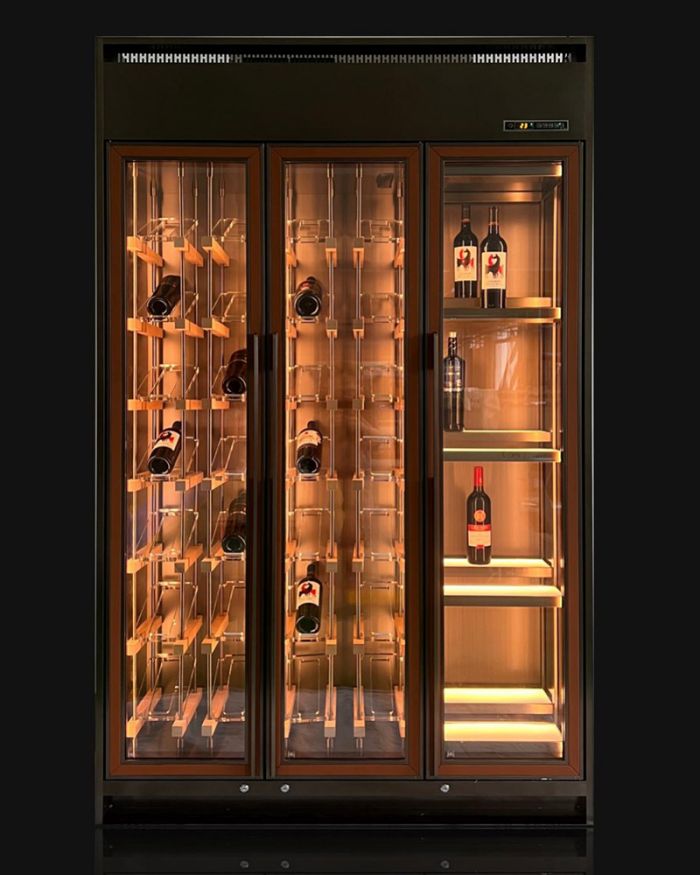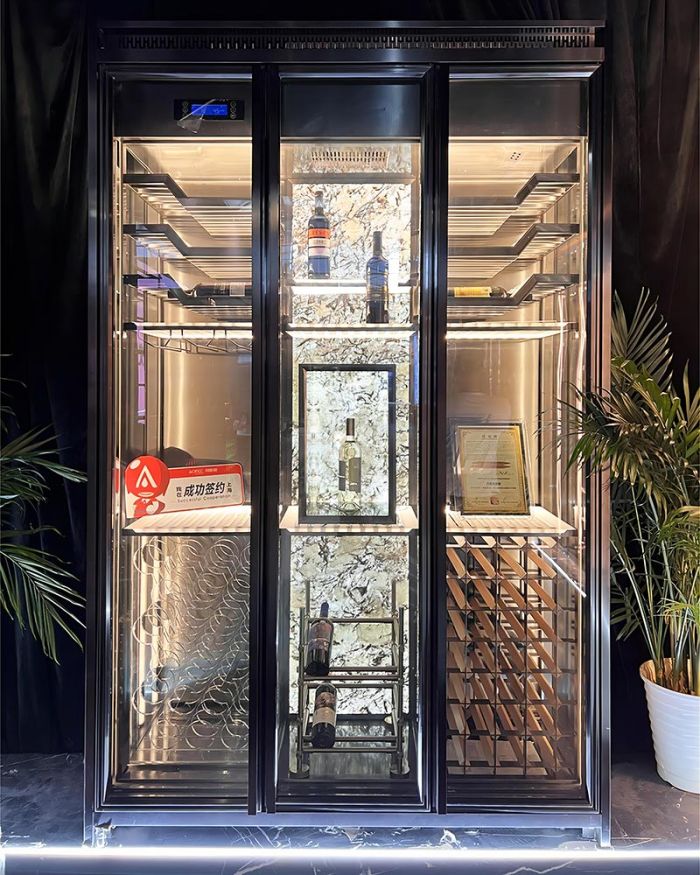Product Description
Temperature Controlled wine cabinet is a device specially used for storing wine. It can maintain the temperature in the cabinet within the set range through the built-in temperature control system, providing a stable and suitable storage environment for wine. This type of wine cabinet usually has good insulation performance and ventilation system to prevent the influence of external temperature changes and odor on the quality of wine, so as to better maintain the taste and quality of wine.

Temperature Controlled Wine Cabinet Specifications:
| Item | Parameters |
| Product No. | RT001 |
| Standard Size | W1380*H2400*D500mm |
| Material | 304 Stainless Steel |
| Surface | Deep PVD Vacuum Plating, No Fingerprints |
| Lighting | Energy Saving |
| Compressor | Imported Embraco |
| Layer | Transparent Acrylic |
| Door | Hollow Electric Glass |
| Filling Material | Thermal Insulation Polyurethane |
| Colors | Brushed Gunmetal Black |
| Factory Nature | China Suppliers Manufacturers Exporter |

Temperature Controlled Wine Cabinet Features:
Temperature Controlled: It has a precise temperature control system, which can stabilize the temperature in the cabinet within the set range, such as between 5℃ and 20℃, according to different wine types and storage requirements, providing an ideal aging environment for wine.
Wine cabinet: Designed specifically for wine storage, it has a reasonable internal structure and is usually equipped with shelves suitable for placing wine bottles. It has high space utilization and can store multiple bottles of wine.
Stainless steel material: The cabinet body is made of stainless steel, which has good corrosion resistance and durability, is not easy to rust, and can keep the wine cabinet tidy and beautiful for a long time. It is also easy to clean and maintain.
Glass door: It is equipped with a transparent glass door, which usually has an anti-ultraviolet function, which can effectively protect the wine from ultraviolet damage and facilitate users to check the wine in the wine cabinet at any time, adding to the display effect.
Black appearance: The appearance is mostly black, simple and atmospheric, and can be easily integrated into the decoration style of various homes and commercial places, improving the grade and taste of the overall space.
Good thermal insulation performance: The wine cabinet has an excellent thermal insulation layer, which can effectively block the transmission of external heat, reduce internal temperature fluctuations, ensure that the wine is always in a stable temperature environment, and reduce energy consumption.
Ventilation system: Built-in ventilation device to maintain air circulation inside the wine cabinet, prevent odor accumulation, ensure that the aroma of the wine is not affected, and maintain its original flavor.
Anti-vibration design: Adopt low-vibration compressor and stable structural design to reduce vibration during operation of the wine cabinet, avoid adverse effects on the wine, and protect the quality of the wine.

Temperature Controlled Wine Cabinet Application:
Restaurant: In a restaurant, the Temperature Controlled Wine Cabinet can be placed in the dining area or wine display area to store and display various types of wine, which is convenient for customers to choose. At the same time, it enhances the professional image and grade of the restaurant and provides customers with a better dining experience.
Bar: The bar uses the wine cabinet to store various wines to ensure that their quality is not affected. The wine cabinet can also be used as part of the bar decoration to create an elegant atmosphere, attract customers to stop and enhance the overall style of the bar.
High-end hotel: High-end hotels pay attention to details and service quality, and use temperature-controlled wine cabinets to properly preserve wine to ensure that customers are provided with the best quality wine. The existence of wine cabinets also reflects the hotel's emphasis on customer experience and helps to enhance the competitiveness of the hotel.
Banquet hall: When holding a banquet, a large amount of wine is needed to meet the needs of guests. The Temperature Controlled Wine Cabinet can store the wine at a suitable temperature in advance to ensure that the best tasting wine can be provided to guests during the banquet, improving the overall grade and satisfaction of the banquet.
Private residence: For wine lovers, equipping a temperature-controlled wine cabinet at home can make it convenient to enjoy fine wine at any time. It is not only a storage tool, but also a part of home decoration, showing the owner's taste and attitude towards life.
Hotel: Some high-end hotels will equip guest rooms or restaurants with wine cabinets to provide guests with high-quality wine services, increase guest satisfaction, and enhance the hotel's service level and brand image.
Café: Some cafes also provide drinks such as wine. Using temperature-controlled wine cabinets can ensure the quality of wine, bring customers a better consumption experience, and enrich the business content of the cafe.

Temperature Controlled Wine Cabinet Uses Notes:
Temperature setting: According to the type and requirements of the stored wine, the temperature of the wine cabinet should be set reasonably. Different types of wine have different requirements for storage temperature. For example, red wine is generally suitable for storage between 16℃-20℃, while white wine and champagne are suitable for storage at lower temperatures.
Avoid frequent opening and closing of the door: Frequent opening and closing of the wine cabinet door will cause internal temperature fluctuations, affecting the stable storage of wine. Therefore, in daily use, the number of door openings and the door opening time should be minimized to maintain a constant temperature in the wine cabinet.
Regular cleaning: Clean the interior of the wine cabinet regularly to remove dust and odors to ensure that the storage environment of the wine is clean and hygienic. When cleaning, be sure to use mild detergents and avoid water entering the electrical components inside the wine cabinet.
Check the sealing: Regularly check whether the sealing strips of the wine cabinet door are intact to ensure that the sealing performance of the wine cabinet is good, prevent cold air leakage and outside air from entering, and affect the temperature and humidity control of the wine cabinet.
Power supply stability: Ensure that the power supply connected to the wine cabinet is stable and reliable to avoid voltage fluctuations from damaging the compressor and other electrical components of the wine cabinet. If necessary, it can be equipped with equipment such as a voltage stabilizer.
Placement: Place the wine cabinet in a dry, well-ventilated location, avoid direct sunlight and heat sources to reduce the impact of external temperature on the wine cabinet, which is also conducive to the heat dissipation and normal operation of the wine cabinet.
Reasonable load: Do not over-stack wine in the wine cabinet, and maintain appropriate spacing so that air can circulate between the bottles to ensure that each bottle can be evenly controlled in temperature to avoid affecting the quality of the wine due to excessively high or low local temperatures.
Regularly check the wine: Regularly check the wine in the wine cabinet to see if the wine label is clear, whether the bottle is leaking or damaged, etc., and deal with problematic wines in a timely manner to avoid affecting the storage of other wines.





